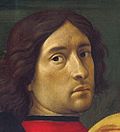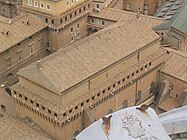File:The.Calling.of.the.First.Apostles.jpg

Original file (1,400 × 864 pixels, file size: 195 KB, MIME type: image/jpeg)
Captions
Captions
| Domenico Ghirlandaio: Calling of the First Apostles
|
|||||||||||||||||||||||||||
|---|---|---|---|---|---|---|---|---|---|---|---|---|---|---|---|---|---|---|---|---|---|---|---|---|---|---|---|
| Artist |
|
||||||||||||||||||||||||||
| Title |
English: "Calling of the First Apostles"; also "Calling of the Apostles" |
||||||||||||||||||||||||||
| Object type |
fresco |
||||||||||||||||||||||||||
| Genre |
religious art |
||||||||||||||||||||||||||
| Description | |||||||||||||||||||||||||||
| Depicted people |
Jesus |
||||||||||||||||||||||||||
| Date |
1481 |
||||||||||||||||||||||||||
| Medium |
fresco and fresco painting |
||||||||||||||||||||||||||
| Dimensions |
height: 349 cm (11.4 ft) dimensions QS:P2048,+349U174728 dimensions QS:P2049,+570U174728 |
||||||||||||||||||||||||||
| Collection |
institution QS:P195,Q2943 |
||||||||||||||||||||||||||
| References | |||||||||||||||||||||||||||
| Source/Photographer |
Web Gallery of Art: reference_wga QS:P973,"http://www.wga.hu/html/g/ghirland/domenico/3fresco/2sistin.html" |
||||||||||||||||||||||||||
| Permission (Reusing this file) |
|
||||||||||||||||||||||||||
File history
Click on a date/time to view the file as it appeared at that time.
| Date/Time | Thumbnail | Dimensions | User | Comment | |
|---|---|---|---|---|---|
| current | 01:12, 25 May 2009 |  | 1,400 × 864 (195 KB) | ISa1 (talk | contribs) | {{Information |Description= The Calling of the First Apostles(calling of the first Apostles, Peter and Andrew, Saint Jacob and Saint John are in the boat) |Source= From the Sistine Chapel walls |Date= ca. 1481–82 |Author= fresco by Domenico Ghirlandai |
You cannot overwrite this file.
File usage on Commons
The following page uses this file:
File usage on other wikis
The following other wikis use this file:
- Usage on arz.wikipedia.org
- Usage on en.wikipedia.org
- Usage on en.wikibooks.org
- Usage on fr.wikipedia.org
- Usage on it.wikipedia.org
- Usage on nl.wikipedia.org
- Usage on sk.wikipedia.org
Metadata
This file contains additional information such as Exif metadata which may have been added by the digital camera, scanner, or software program used to create or digitize it. If the file has been modified from its original state, some details such as the timestamp may not fully reflect those of the original file. The timestamp is only as accurate as the clock in the camera, and it may be completely wrong.
| JPEG file comment | GHIRLANDAIO, Domenico
(b. 1449, Firenze, d. 1494, Firenze) Calling of the Apostles 1481 Fresco, 349 x 570 cm Cappella Sistina, Vatican The fresco is from the cycle of the life of Christ in the Sistine Chapel, it is located in the third compartment on the north wall. Vasari wrote: "...Domenico represented Christ calling Peter and Andrew from their nets, and the Resurrection of Christ, the greater part of which is now destroyed, for it was above the door..." Later, the Resurrection vanished completely in the destruction of the wall. In the early 1480s Pope Sixtus IV brought a number of famous Tuscan and Umbrian artists to Rome in order to decorate his new court chapel, the Sistine Chapel. Ghirlandaio must already have made a name for himself with his commissions, primarily the frescoes for the Saint Fina Chapel, in order to be considered for a task of this importance. The chapel's ceiling would not be decorated with Michelangelo's famous frescoes until the reign of Sixtus' nephew, Julius II. Between 1481 and 1483, the walls of the chapel were covered with frescoes by Sandro Botticelli, Domenico Ghirlandaio, Cosimo Rosselli, Piero di Cosimo and others - probably under the direction of Pietro Perugino. On the left are scenes from the life of Moses, and on the right scenes from the life of Christ, a typological arrangement that sees Moses as the predecessor of Christ. This cycle of frescoes became one of the major artistic achievements of the Italian Quattrocento. In accordance with the Pope's wishes, in each picture several episodes of a story were presented together, a practice that by this time was already becoming outdated. The two frescoes Ghirlandaio painted were the Calling of Saint Peter and Resurrection. By Vasari's time the second fresco had been largely destroyed and an entirely new version was painted in the 16th century. The surviving work is divided into two zones. In the foreground, on a shallow stage, Ghirlandaio depicted several groups of people, tightly packed together in rows. At the centre Christ is blessing the kneeling brothers Simon, Peter and Andrew, His first disciples. They follow Him and appear again in the background on the right. There they witness Christ calling James and John, who are sitting in a boat mending their nets with their father, Zebedee. The massiveness of the heavy garments worn by the figures in the main scene in the centre foreground is reminiscent of Masaccio's frescoes in the Brancacci Chapel dating from about 1424 -1428. It is mainly Masaccio's Tribute Money that matches this one in terms of colour, landscape, figure types. It is at the sides of the picture field that Ghirlandaio dares to display his own developing style. The group of women on the left, including a woman in blue seen from behind, anticipates the female figures he paints in later works. In this fresco he also gives a free rein to the highly individual style of portraiture he had developed in the Vespucci and Saint Fina chapels. On the right, arranged in an exactly level row like pearls on a string, are members of the most influential Florentine families who maintained residences in Rome. In the centre stands Giovanni Tornabuoni, representing the Medici family's merchant bank. He later became a sponsor of Ghirlandaio and was made the Pope's treasurer despite the enduring enmity between Pope Sixtus IV and the Medici. His son Lorenzo Tornabuoni - in front of him, wearing a black garment - lived to see his wife die young and his family go bankrupt after his father's death. In 1477, Ghirlandaio painted two episodes from the life of Saint John the Baptist and two from the life of the Madonna for the mortuary chapel of Lorenzo's mother, Francesca Pitti Tornabuoni, in the church of Santa Maria sopra Minerva in Rome. According to Vasari, these works were very famous at the time; unfortunately they no longer exist, though two charming portraits of Lorenzo's wife, Giovanna Tornabuoni, who died young, have survived. To the right of Giovanni Tornabuoni stands the humanist John Argyropoulos, wearing a white beard. He wrote commentaries on Aristotle and fled to Florence from Constantinople when the city fell to the Turks in 1453. A friend of Cosimo de' Medici, he spent fifteen years as a court scholar and professor of Greek at the University of Florence, until he was summoned to Rome by the Pope. He nonetheless continued to see himself as a Florentine, as Lorenzo de' Medici had accorded him civil rights there. The nobleman beside him, with white hair and no hat, is thought to be either Francesco Soderini from Florence, or Raimondo Orsini from Rome. The young man behind him, with the brightly shining face, is thought to be Antonio Vespucci. Separate from the other Florentines, behind Christ, stands Diotisalvi Neroni, an earlier friend of Cosimo de' Medici. He lived in a more or less willing exile in Rome, as he was involved in plots against Cosimo's son Piero. It was not only his skill in portraits but also his skill in landscapes, visible in the fresco in the Sistine Chapel, that made Ghirlandaio famous. The entire upper half of this work is devoted to an extensive landscape with a high horizon. The Sea of Galilee, hemmed in by hills and mountains, is snaking its way like a river into the background, where, in accordance with aerial perspective, the colours are paler and lighter. In the sky brightly coloured birds are swooping - birds derived from Benozzo Gozzoli's Procession of the Magi, painted between 1459 and 1461 for the Florence Medici palace, and also from works by Domenico Veneziano.
Author: GHIRLANDAIO, Domenico Title: Calling of the Apostles Time-line: 1451-1500 School: Italian Form: painting Type: religious |
|---|
Structured data
Items portrayed in this file
depicts
- Pages with complex technique templates
- Images from Web Gallery of Art
- PD-old missing SDC copyright status
- CC-PD-Mark
- PD-Art (PD-old-100)
- PD-Art missing SDC copyright status
- Artworks with Wikidata item
- Artworks digital representation of unknown type of work
- WGA form: painting
- WGA type: religious
- WGA School: Italian
- WGA time period: 1451-1500


